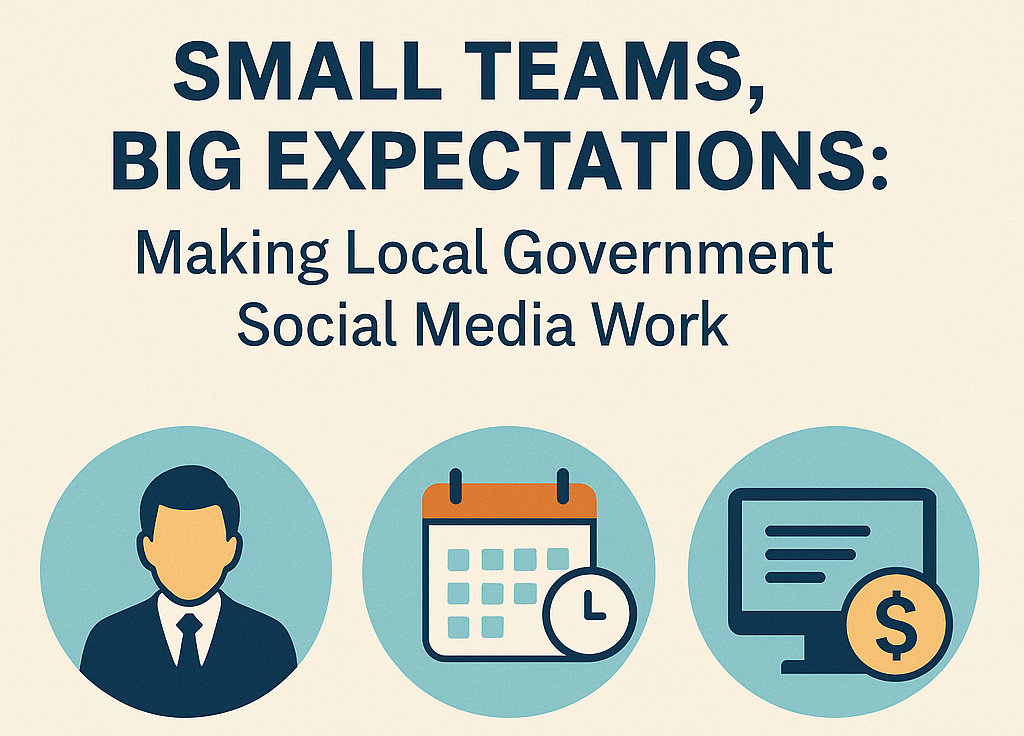Limited Time, Limited Resources
Local governments typically have limited time and limited resources, so managing social media isn't a priority. Here, we discuss some easy steps local governments can take to reclaim control of their digital presence.
7/7/20253 min read


If you work in local government — whether you're a PIO, a city manager, a part-time council member, or a communications generalist — you already know that social media matters. But it's rarely the priority. We've spent the last year talking with dozens of local officials across the U.S., from coastal towns and suburban counties to mid-sized cities and rural main streets. They all said the same thing in different ways: "We want to communicate better, but we're overwhelmed."
Here's what we heard most — and what local governments can do to reclaim control of their digital presence.
You're Doing 10 Jobs, and Social Media Is Just One
Most local government communicators wear a lot of hats. You might be handling press releases, event logistics, newsletter design, constituent questions — and only then getting around to Facebook or Instagram. In Johnston County, NC, one official told us they manage 25 departments' content with two staff and an intern. Over in Grand Island, NE, someone else admitted they do everything manually across 19 pages. And in Morehead City, NC, the refrain was familiar: "We know we should post more, but it's always a scramble."
That's not poor planning — that's local government reality. The result is a reactive, last-minute approach that leaves residents disconnected and staff burned out.
There's No Workflow — Just Inbox Chaos
In the private sector, social media teams have ticketing systems, content calendars, even dedicated video editors. In local government? It's usually a flurry of emails, forwarded PDFs, or "Hey, can you post this real quick?" Even teams with strong instincts lack shared systems. Many rely on spreadsheets, sticky notes, or someone's memory to manage post requests and approvals.
The feedback we received painted a clear picture. Some teams are using GChat, email, and what one person called "vibes" to coordinate. Others mentioned that if they're out sick, nothing gets posted. And perhaps most frustrating, by the time the mayor approves a post, the event's already over. This isn't a failure of effort — it's the absence of systems designed for government workflows.
The Tools Are Expensive — and Not Built for You
Hootsuite, Sprout, CivicPlus — these tools are powerful, but they're also pricey, complex, and designed for agencies with full-time communications teams. Small and mid-sized local governments often can't justify spending $5,000 to $12,000 per year for social software. They can't wait six months to onboard and train staff. What they really need is something simple that helps them post more effectively.
As one official put it: "I don't want an enterprise platform. I want a boost." This sentiment captures the disconnect between what's available and what's actually useful for resource-constrained teams.
What's Actually Working in Local Government
Despite the challenges, some local teams are finding their rhythm. Here's what they're doing differently — and what you can try, even without new hires or big budgets.
First, establish a lightweight routine. Create a recurring content rhythm that doesn't have to be fancy. You might designate Mondays for "This Week in Council" posts, Wednesdays for Public Works updates, and Fridays for event spotlights or community partner shares. Use Google Forms or a shared document to collect department ideas ahead of time. Even small structure can have big impact.
Second, build a repost reserve. Start collecting evergreen content that you can reuse, including safety reminders for fireworks, storms, and road closures; department introductions or staff shout-outs; and past successful posts that still apply. On slow weeks, pull from this vault. Local governments don't need to be original every time — just relevant and reliable.
Finally, use the right tool for the job. We built our tools specifically for local governments with no bloated feature sets and no $10,000 contracts. Instead, we offer post suggestions based on what other cities and counties are doing, searchable databases of real posts on tough topics like taxes, school closings, and development, and templates and reminders that help solo staffers get ahead, not fall behind. We're keeping it simple, affordable, and month-to-month — because we know how procurement works (or doesn't).
The Bottom Line: You're Not Failing — You're Under-Resourced
We've seen firsthand how much local teams care about informing and connecting with their communities. But when you're buried in tasks and running on empty, even a good social media plan feels out of reach. It doesn't have to be that way.
If you're ready to spend less time scrambling and more time engaging — with your voice, your values, and your community — we're here to help. Want to see examples from towns like yours? Or get three post ideas this week, no strings attached? Reach out and connect with us.
